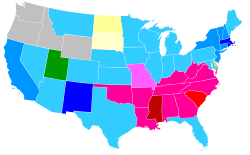The term Bible Belt refers to a region of the Southern United States and the Midwestern state of Missouri (which also has significant Southern influence), where Protestantism exerts a strong social and cultural influence. The region has been described as one of the most socially conservative across the United States due to a significant impact of Protestant Christianity on politics and culture. The region is known to have a higher church attendance, more evangelical Protestant denominations, and greater emphasis on traditional religious values compared to other parts of the country. The region contrasts with the religiously diverse Midwest and Great Lakes and the Mormon corridor in Utah, southern Idaho, and northern Arizona.
Whereas the states with the highest percentage of residents identifying as non-religious are in the West and New England regions of the United States (with Vermont at 37%, ranking the highest), in the Bible Belt state of Alabama it is just 12%,[1] while Tennessee has the highest proportion of evangelical Protestants, at 52%.[2] The evangelical influence is strongest in Alabama, Georgia, North Florida, Mississippi, Arkansas, Tennessee, Kentucky, southern Missouri, Western North Carolina, the Upstate region of South Carolina, Oklahoma, northern and eastern Texas, southern and western Virginia, and West Virginia.
The earliest known usage of the term "Bible Belt" was by American journalist and social commentator H. L. Mencken, who in 1924 wrote in the Chicago Daily Tribune: "The old game, I suspect, is beginning to play out in the Bible Belt."[3] In 1927, Mencken claimed the term as his invention.[4][5] The term is now also used in other countries for regions with higher religious doctrine adoption.

The name "Bible Belt" has been applied historically to the South and parts of the Midwest, but is more commonly identified with the South.[6] It encompasses both the Deep South and Upland South. In a 1961 study, Wilbur Zelinsky delineated the region as the area in which Protestant denominations, especially Southern Baptist, Methodist, and evangelical, are the predominant religious affiliations.
The region includes most of the Southern United States, including most of Texas and Oklahoma, and in the states south of the Ohio River such as Kentucky and Tennessee, and extending east to include central West Virginia and Virginia, from the Shenandoah Valley southward into Southside Virginia and North Carolina. In addition, the Bible Belt covers most of Missouri and the southern parts of Illinois, Indiana, and Ohio.
On the other hand, areas in the South which are not considered part of the Bible Belt include heavily Catholic Southern Louisiana, religiously diverse Central and South Florida, overwhelmingly Hispanic South Texas and Trans-Pecos, and Northern Virginia in the Washington metropolitan area. A 1978 study by Charles Heatwole identified the Bible Belt as the region dominated by 24 fundamentalist Protestant denominations, corresponding to essentially the same area mapped by Zelinsky.[7]
According to Stephen W. Tweedie, an Associate Professor Emeritus in the Department of Geography at Oklahoma State University, the Bible Belt was viewed in terms of numerical concentration of the audience for religious television when he first published his research in 1995.[8] He finds two belts: one more eastern that stretches from North Florida through Georgia, Alabama, Tennessee, Kentucky, Southside Virginia, and the Carolinas; and another concentrated in Texas (excluding El Paso and South Texas), Arkansas, Louisiana, (excluding New Orleans and Acadiana), Oklahoma, Missouri (excluding Kansas City and St. Louis), and Mississippi.[9] "[H]is research also broke the Bible Belt into two core regions, a western region and an eastern region. Tweedie's western Bible Belt was focused on a core that extended from Little Rock, Arkansas, to Tulsa, Oklahoma. His eastern Bible Belt was focused on a core that included the major population centers of Alabama, Georgia, and Tennessee.[10]
A study was commissioned by the American Bible Society to survey the importance of the Bible in the metropolitan areas of the United States. The report was based on 42,855 interviews conducted between 2005 and 2012. It determined the 10 most "Bible-minded" cities were Knoxville, Tennessee; Shreveport, Louisiana; Chattanooga, Tennessee; Birmingham, Alabama; Jackson, Mississippi; Springfield, Missouri; Charlotte, North Carolina; Lynchburg, Virginia; Huntsville-Decatur, Alabama; and Charleston, West Virginia.[11] A study by the Pew Research Center in 2016 found that the ten most religious states were Alabama, Mississippi, Tennessee, Louisiana, Arkansas, South Carolina, West Virginia, Georgia, Oklahoma and North Carolina.[12] A 2014 study by the Pew Research Center found that the states with the highest belief in the Bible as the literal word of God were Mississippi (56%), Alabama (51%), South Carolina (49%), West Virginia (47%), Tennessee (46%), Arkansas (45%), Louisiana (44%), Georgia (41%), Kentucky (41%), and Texas (39%).[13]
